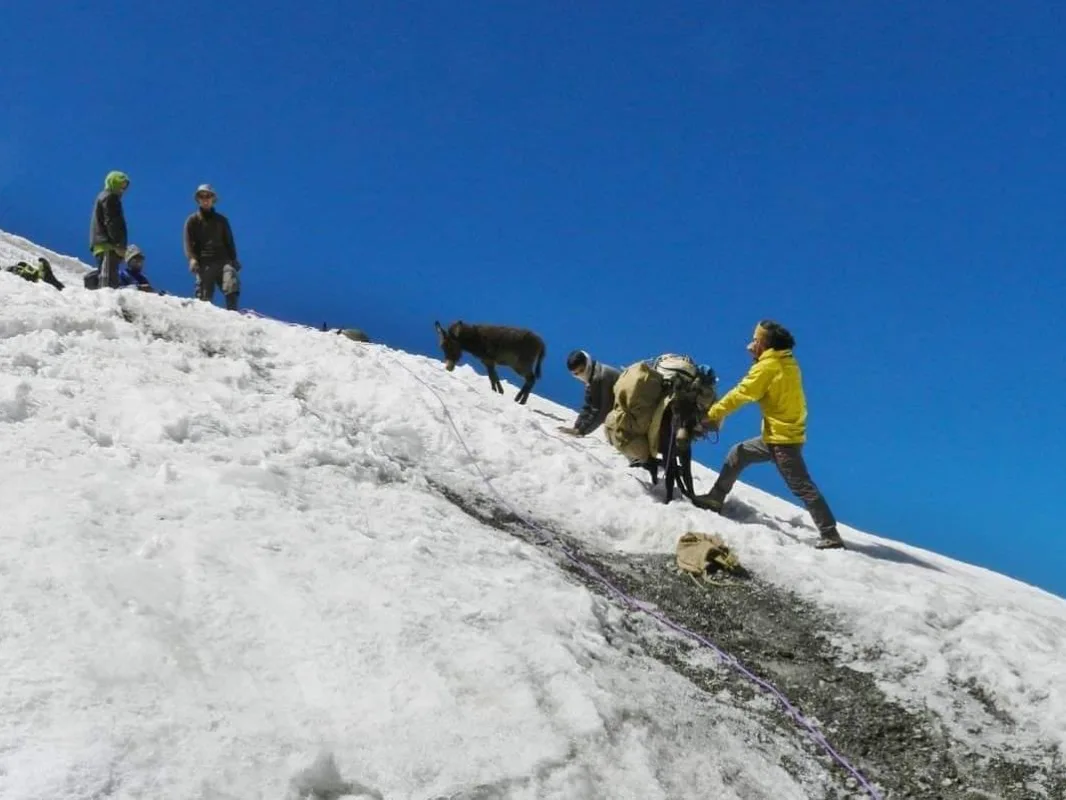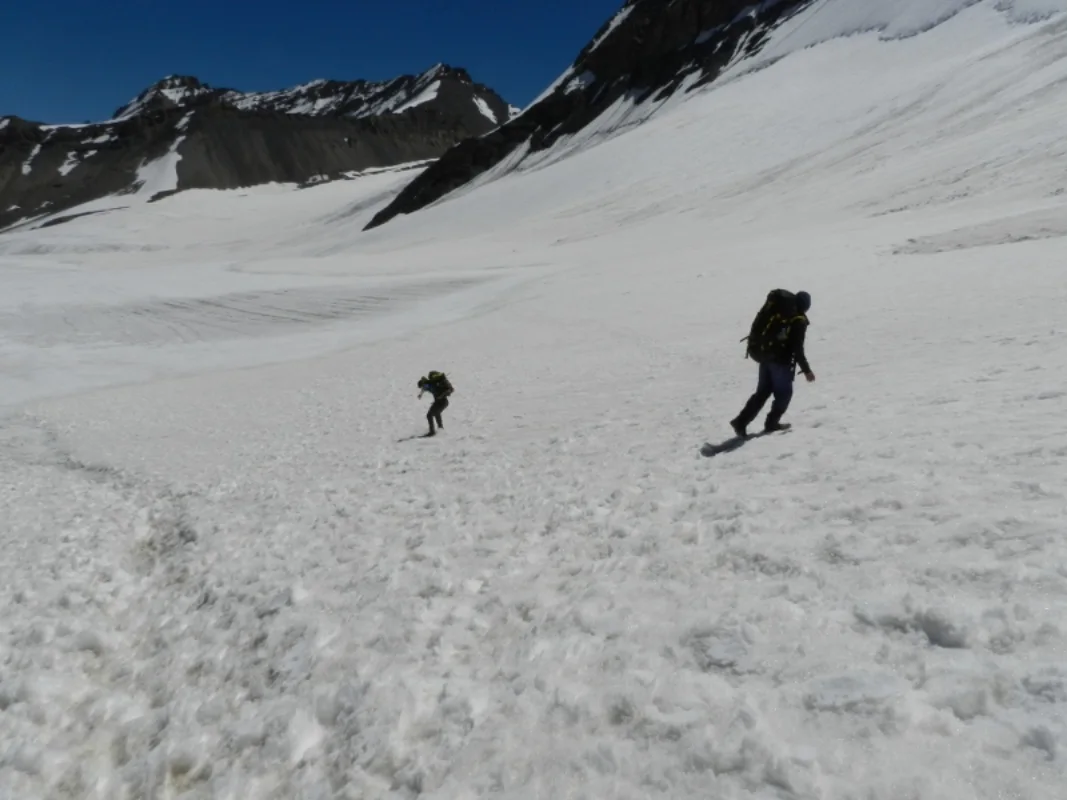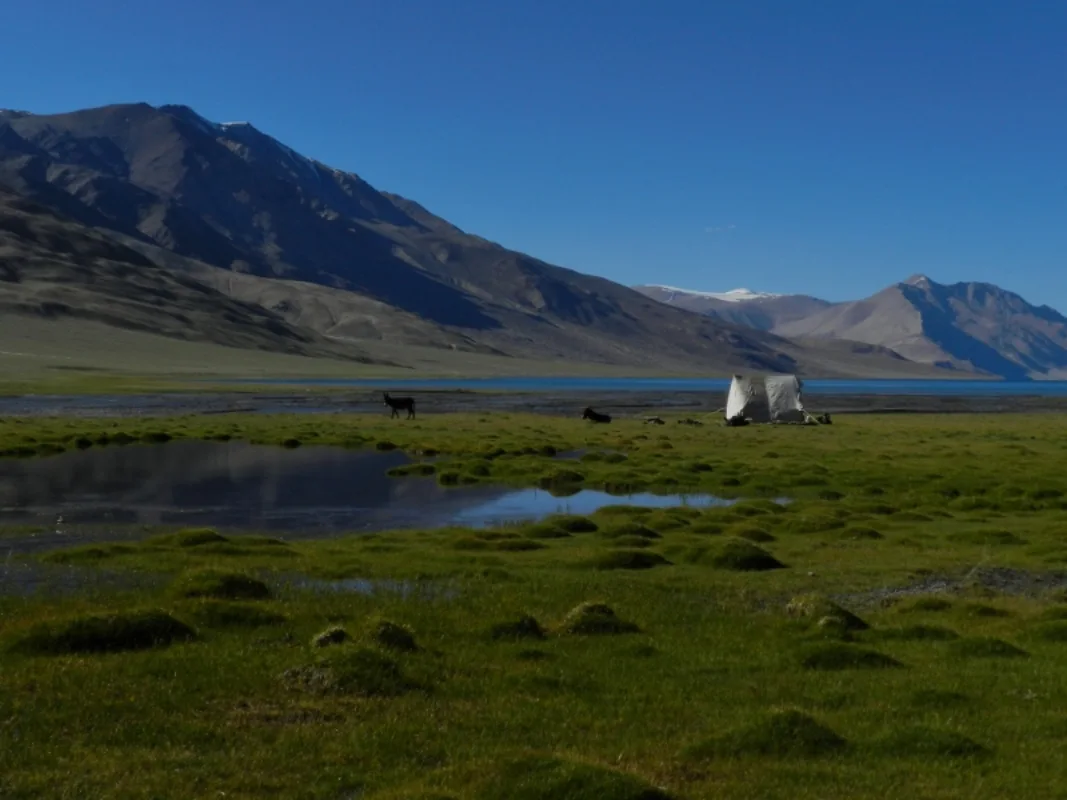Parang La Trek
- 8 Nights 9 Days
- 5600 m
- Hard
- Spiti , Kibber , Leh
Rs 45,000/-
One of the popular high-altitude passes and beautiful trails in the western Himalayas starts from Kibber in Spiti and ends in Korzok (lake) tsoitio moriri leh, a turquoise colour lake at an elevation of 4595m. This is a traditional trade route between Ladakh and Spiti with tough terrain and high elevation. Parang la is an old trade route between Spiti in Himachal and Tibe and Changthang.
Day 1 - Kaza to Key/Kibber to Dumla

- 4 to 5 hours
- 4200 m
We started our trek after spending time acclimating to the high altitude in Kaza. Today we drove from Kaza to Kibber. In between we will visit the key monastery one of the 108 monasteries built in one night- an 11th-century Buddhist site- famous for its architecture and wall paintings of lord buddha. then we drive to Kibber which is at an elevation of 4205m highest human settlement in the world and start our trek from Kibber to Dumla. On the way to Dumla, we cross several deep and narrow river gorges, on reaching we camp in Dumla meadows for an overnight stay in tents.
Day 2 - Dumla to Thaltak

- 3 to 4 hours
- 4600 m
Today we will climb to a high ridge and descend to the beautiful meadows of Thalthak from where you have a beautiful view of Kanamo Peak 6000m and overlooks of deep gorges. The trail passes through varying terrains consisting of moraines, lose rocks, and grassy pastures. It will be a gradual walk taking 3 – 4 hours to reach Thaltak Meadow. We will pitch our tents after reaching, have dinner in the evening and stay overnight in tents here.
Day 3 - Thalthak to Bongrojen

- 6 to 7 hours
- 5050 m
It is going to be a day that requires good strength to walk. After feasting on the healthy breakfast at the campsite, we will start walking ahead. We will follow a steep trail and descend to a gorge, Paralungbi Gorge and then follow it upstream. The walks through a rocky trail to reach the campsite. After walking for approx 4-5 hours we will reach Bongrojen. We will pitch our tents here for the night.
Day 4 - Bongrojen to Parangla to Dak Karzong

- 5 to 6 hours
- 4850 m
Crossing the pass requires less patience than other crossovers. We will cross the pass today, on the third day of the trek.We start early for the pass in the morning after breakfast. It will take 2-3 hours to reach the pass. After reaching the pass you will notice beautiful views of Spiti and Changthang valleys. Stand atop pass, 5600 m and embrace your achievement. After a while , we will start descending towards the Pare Chu river. While negotiating the downhill journey successfully we will see flat plains on the way to Dak Korzong . It is a flat and barren valley surrounded by high mountains on all the sides. After finding a suitable place to pitch the tents in Dak Karzong, we will stay overnight in tents.
Day 5 - Dak Korzong to Datang Yongma

- 3 to 4 hours
- 4650 m
After getting up in the flat plains of Dak Karzong, we will have breakfast and start our walking journey. We descend along the open plains of Pare Chu to reach Datang Yongma. It will take time of 4-5 hours to reach our next campsite for today. Stay overnight in tents after dinner.
Day 6 - Datang Yongma to Chumik Shilde

- 5 to 6 hours
- 4330 m
The day revolves around walking and reaching Chumik Shilde. We will start towards the next point after breakfast. There will be an easy an easy and almost flat path up to Racholamo. From here the trek comes downhill, passing by the grounds of Norbo Sumdo. Cross a river near Norbo Sumdo on the way to Chumik Shilde. We will pitch tents after reaching the site. After having dinner we will give an end to the tiresome day.
Day 7 - Chumik Shilde to Tso Moriri, Kiangdom

- 5 to 6 hours
- 4450 m
After breakfast, we will walk on vast flat plains to reach Kiangdom. The walk will be on the southern edge of Tso moriri, a turquoise colour lake which is at an elevation of 4595m; it is the largest of high-altitude lakes in the Trans Himalayan biogeographic region, entirely within India. It is a paradise for photographers as the lake changes its colours multiple times a day. It is a home to migratory Black Neck Cranes. After walking for a while we will reach Kiangdom and choose it as our campsite for tonight.
Day 8 - Kiangdom to Korzok

- 6 to 7 hours
- 4500 m
We will start our journey to Korzok, a village in the plains of Leh. After breakfast, we will walk gradually and the trail will take you through long stretches of sandy and barren mountains with a river crossing alongside. After reaching Korzok, we will stay in a local homestay or tents as per availability and give an end to our day here.
Day 9 - Korzok to Leh

- 6 to 7 hours
- 3500 m
After breakfast, we will take a beautiful drive to Leh. It will take 6-7 hours to reach the main city of Leh. We will see you off in Leh and you can check in at your hotel or homestay in Leh and can fly back to your hometown next day as per your flight schedule.
What to pack for the trek ?
| Backpack with rain cover | (50 – 60 ltr) with comfortable shoulder straps |
| Day pack with rain cover | 20 – 30 litre (If off-load opted) |
| Walking stick | Advisable (At least one) |
| Small-size Water Bottle | 2 thermos flask bottles of one litre each, |
| Small size tiffin/lunch box | 1 Nos |
| Snacks | Energy bars, dry fruits, electoral/ORS |
| Personal Medical Kit | Consult your doctor |
| T-Shirt (Synthetic quick dry) | 1 Half sleeves |
| Fleece T-shirt | 1 Nos |
| Wind stopper / Fleece jacket | 1 Nos |
| Windproof Jacket | 1 Nos |
| Down feather / Hollow jacket | 1 Nos |
| Thermal inner (Upper and Lower) | 1 Pair |
| Trek Pant (Synthetic quick dry) | 1 Nos |
| Wind stopper / Fleece Pant | 1 Nos |
| Waterproof gloves | 1 Pair |
| Fleece / woollen gloves | 1 Pair |
| Poncho / waterproof Jacket and pant | 1 Nos |
| Head torch | 1 Nos. (Avoid Hand torch) |
| Sun Cap | Not required |
| Woolen Cap | 1 Nos. |
| Balaclava | 1 Nos |
| Buff | 1 Nos (Woollen) |
| Sunglasses | UV with dark side cover, People who wear spectacles – (A)- Use contact lenses | (B)- Photo chromatic glasses |
| Sunscreen | 1 Nos |
| Moisturiser | 1 Nos |
| Chapstick / Lip balm | 1 Nos |
| Toothbrush and toothpaste | 1 Nos |
| Toilet paper & Wipes | 1 Nos |
| Soap/hand sanitisers | 1 Nos |
| Antibacterial powder | 1 Nos |
| Quick dry towel | 1 Nos |
Points to Remember
- Accommodation: You will be provided tents on a twin-sharing basis including all the basic commodities; mattress- R Value 4, Sleeping bag, and Lamp.
- Meals: You will be provided nutritious meals during the trek to keep you energised and strengthened.
- Transportation: A transfer from the rendezvous to the defined destination will be provided during the trek. This is optional* also.
- Trekking gear: Basic trekking gear; trekking poles, micro-spikes, and gaiters will be provided for the snowy region.
- First Aid: A basic first aid kit will be there in case of a minor injury or illness.
- Personal Clothing: The clothing for the trek must be of your own.
- Meals during transit: When we are transferring you from one point to another, there will be no meals provided from our side.
- Personal Expenses: Any kind of personal expenses are not covered in the trek.
- Emergency Evacuation Cost: The cost for any emergency evacuation stands exclusive from the trek. The participant has to bear the expenses, although supporting staff will be there till you get better again.
Building Strength :
- Spare some time for a 2-3 km walk daily at least 20 days before the trek.
- You can add some breathing exercises to the routine as well.
- You can strengthen your cardiovascular system by cycling and jogging.
Mental Strength :
- Learn to maintain a positive attitude and understanding out in the mountains.
- Prepare yourself to adapt to any change depending on the weather and other uncontrollable situations.
- No intoxication: Any kind of mischievous activity like drinking, or smoking is not permitted on the trek. One who tries to go beyond the bottleneck limits will be sent back to the base camp.
- Indemnity form: It is important to tell about your complete willingness to join this trek by filling out and submitting an indemnity form that can be downloaded from the website.
- Leave no trace technique: We work on the motive of ” take memories and leave no trace.” Throwing any kind of plastic wrappers on the trails is strictly prohibited. If you find any you can pick that up also.
- Quick-drying clothes: Carry some quick-drying inner layers to stay comfortable while walking, specifically during the monsoon season.
- Rain gear: Keep a raincoat or rain jacket along with rain pants for unpredictable showers.
- Sunglasses and Sunscreen: It is a protective layer you need to protect your eyes from the harsh and bright light and strong UV rays of the sun in the mountains.
- Personal Toiletries: It is advisable to carry your limited toiletries to not be a part of environmental deterioration. Please avoid carrying wet wipes as they are non-biodegradable and can leave a ton of microplastic back on the trail
- Your body reacts very differently when you are out in the mountains, this is because of the changing altitude, wind chill factor and air pressure that can lead to a disturbance in your body during the trek, just to avoid that a little bit of hard work will pay you well.
- An open mind is the biggest quality you should keep when you are this far from your home. There can be lots of unexpected things you have to experience for the first time yet a smiling face and courageous personality will help you in every tricky situation
- Throwing any kind of plastic back on the trail will show your intellectual level only and taking it back with you is a step towards preserving what we have.
We will be visiting eco-sensitive areas while trekking, using some small practices can minimize the impact of our visit to these areas. Here are some important yet ignored facts that can help us to keep the environment intact:
Stick to Established Trails
- Stay on Trails: If we use the existing trails to walk on, it will not tamper with the local vegetation and keep the life of microorganisms in the area safe.
- Avoid Shortcuts: If we take shortcuts, it can destroy the plantation and disturb the ecology.
Minimize Campfire Impact
- Using a Stove: We will carry a portable camping stove instead of a campfire to cook food. We won’t light fire unnecessarily just to avoid the destruction of nature and let our bodies adjust to the temperature.
- Fire Regulations: If in any case fire has to be lit, we will use established fire rings to keep the fires small. We will ensure they are completely extinguished before leaving.
Dispose of Waste Properly
- Leave no trace: We will Carry all the trash out with us, including food scraps and packaging. If you find any kind of wrapper or trash on the trail, you can pick it up and hand it to us at the campsite to get it disposed of properly.
- Human Waste: You can use restroom facilities where available. In remote areas, dig a cat hole (6-8 inches deep, at least 200 feet from water sources, trails, and campsites) and cover it properly after use. Using wet wipes is harmful thing for the environment, you can Consider using biodegradable toilet paper.
Respect Wildlife
- Keep a Distance: We can Observe the animals from a distance to avoid disturbing them, chasing them will not be considered as the right thing to do.
- Do Not Feed Animals: Feeding wildlife can disrupt their natural behaviours and diet.
Leave What You Find; Enjoy the things from where they are
- Take Only Memories: Do not take the rocks, pluck plants, and pick other natural objects as you find them to preserve the environment.
- Avoid Disturbing Historical and Cultural Sites: Respect any cultural or historical artefacts you encounter.
Reduce Use of Pollutants
- Eco-friendly Products: You can use biodegradable soap and avoid contaminating water sources.
- Minimize Noise Pollution: Keep noise levels low to avoid disturbing wildlife and other trekkers.
Travel in Small Groups
- Limit Group Size: Trekking is a smaller group that has less impact on the environment.
Educate Yourself and Others
- Learn and Share: Educate yourself about Leave No Trace principles and share this knowledge with fellow trekkers.
Support Conservation Efforts
- Contribute to Local Conservation: You can support organizations and initiatives that are working towards preserving natural areas.
Upcoming Tours
This can be your next getaway for your upcoming vacations
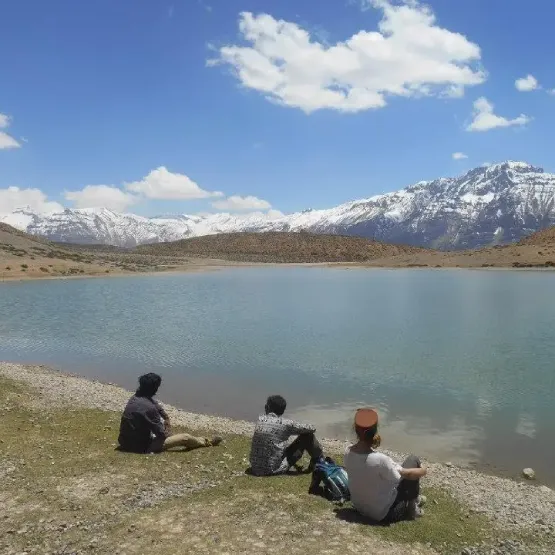
SPITI VALLEY ROAD TRIP
A thrilling journey to the Land of Lamas offering scenic views of the Himalayas, Buddhist culture and architecture .
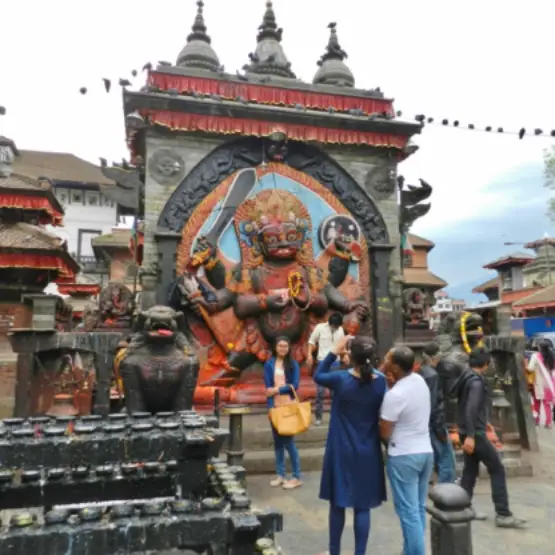
NEPAL ROAD TRIP
A country on the southern slopes of the Great Himalayan ranges offering you culture, tradition and scenic views.

CHANDARNAHAN LAKES TREK
A trek in the outskirts of Shimla taking you closer to the nature and inner realms of Shimla.
Call us for a free quote
We are here to plan your upcoming adventure, give us a call today!
For travel related queries
Info@highinhimalayas.com
Phone
+91 78765 96443
+91 97360 82255
Address
Cabin No. 501, PC Chambers, Near Jodha Niwas Parking, The Mall Road, Shimla, Himachal Pradesh 171001

